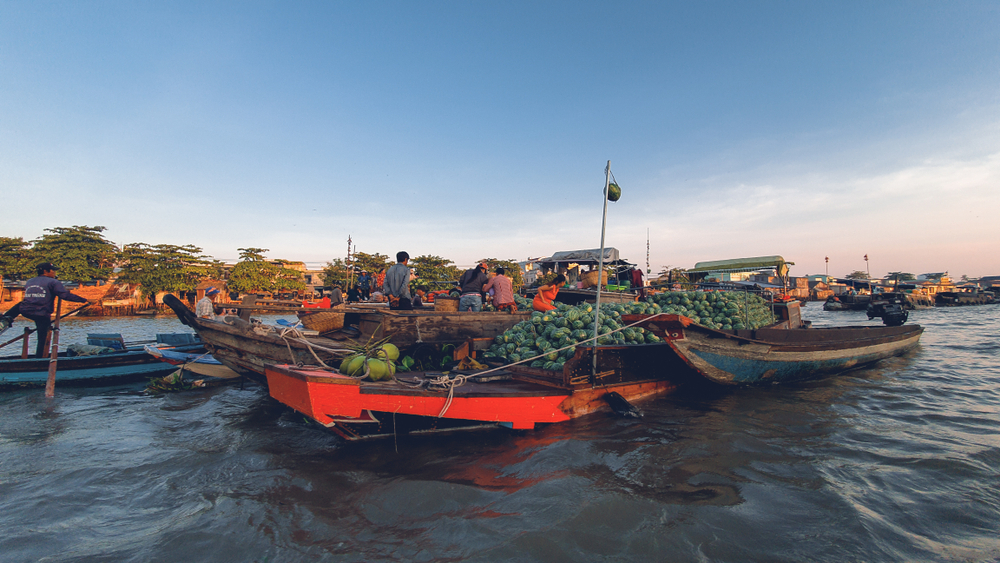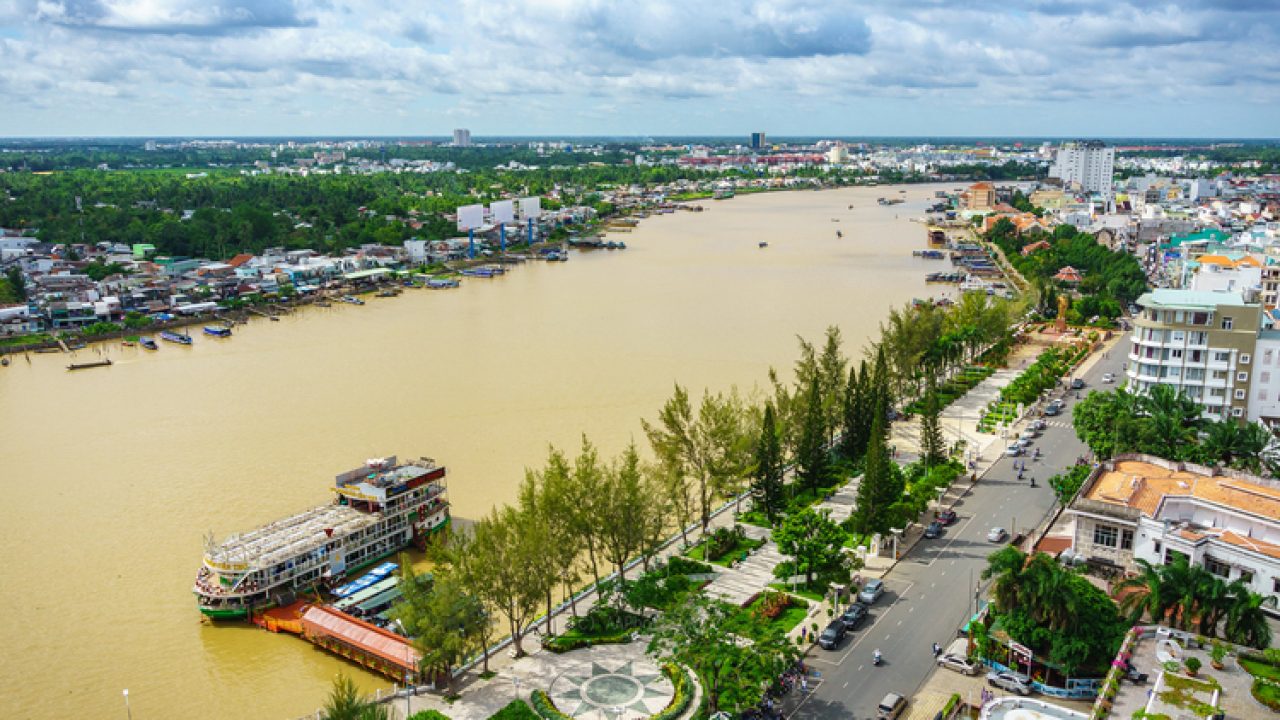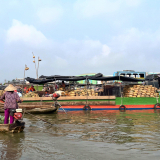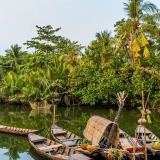Can Tho
Can Tho is the largest city of the Mekong Delta and the fifth-largest in Vietnam, just behind Danang. With a population of over two million, it is home to 3 ethnic groups living together; hence the cultural diversity created and, along with several stunning scenes of nature, attracting tourists from all around the world. Floating markets, orchard gardens, traditional handicraft villages, and festivals are what you could find in this beautiful city, make it worth visiting for anyone setting their foot in Vietnam. Here is the Can Tho travel guide for those who are interested.
Can tho is located right in the centre of the Mekong Delta and was called “the Western Capital” due to its ideal location.
The city itself lies along the left bank of Hau River, which takes its route from the Mother Mekong and enters the East Sea. Here, thousands of boats go back and forth every day, take goods and people from other places with them, make Can Tho the political, economic, cultural, and transportation centre of the Mekong Delta.
As being what it is, the city is buzzing with a full-of-life waterfront lined with sculpted gardens, attracting narrow streets, and wide boulevards, and maybe the best concentration of foreigners within the delta.
It will take you about 175 km from Ho Chi Minh city, 104 km from My Tho, 75 from Chau Doc, and around 100 km from other Mekong provinces, which makes it convenient to travel and combine with other places.

Can Tho City
Can Tho’s history
Can Tho was established as a part of Tran Giang 2000 - 2500 years ago, together with the formation of the Mekong Delta. After the development of the Phu Nam Kingdom and Oc Eo culture, the area turned deserted and sparsely populated. Not until the late 18th century that Mac Cuu settled in the area to cultivate the land had it been divided into several smaller sections, including the present-day.
For years, several legends have been told to explain the name of the city. One had it that Nguyen Anh (the King of the Nguyen Dynasty), on his way to the South, had passed the area and heard the river echo poem recitation, song singing, flute playing in a rhythmical harmony; thus rename it as Cam Thi Giang (beautiful river)., The name was then changed to Can Tho.
Another came from the very fact that people had for a long time planted a lot of dresses and herbs along both sides of the river. As these kinds of vegetables have a distinctive scent and the city was the main transportation spot of them, it was named as Can Thom, then Can Tho.
Besides, as previously mentioned, the city is located right in the center of Mekong Delta, the Western of Vietnam; hence its other name “the Western Capital”.
Weather and climate
Located in the South of Vietnam, Can Tho features seasonal weather, which, throughout the year, experiences the dry and wet seasons.
From December to April is the time the dry season sets in. It is dry and hot with a temperature ranging from 21°C to 34°C. The sun shines averagely 8 hours a day, and rain is rare, which sometimes causes severe drought. The season, by and large, cannot be a suitable time to visit Can Tho. However, the weather condition varies according to each month, which means that not every month experience such harsh weather. For example, from December to February is the beginning of the season; thus, see a lower range of temperature, increased frequency of rain, and more comfortable weather. Also, this time of the year is the busiest for tourists.
The other season of Can Tho takes place between May and October. During the season, rain and humidity increase significantly. Luckily, the city is less affected by storms and natural disasters. Sometimes, from August to November, flooding can occur. The most beautiful time is in the summer (from May to August) when there are full of fruits and bloom orchards, it is a chance for you to visit, enjoy local life and take photos.

Nice weather in Can Tho
How to get there
From Ho Chi Minh City and neighbouring provinces, the tourist should use the bus. You can pick up the bus at Mien Tay Bus Station or contact other coaches to buy tickets. Travel time is about 3-4 hours, and the price will be from $4.13 to $7.83 (95,000 VND to 180,000 VND). Please book the ticket in advance for desired seat positions. Besides, private cars for families or groups of friends are about $121.75 (2,800,000 VND). Direct flights are not available.
From Hanoi or Da Nang to Can Tho, you can take the direct flight, which takes about 2 hours and cost you from $63.05 to $91.75 (1,450,000 VND to 2,110,000 VND). The airport is only about 10 km from the city, so you can take a taxi easily to reach the centre.
In Can Tho, you should rent a motorbike to visit this city. Motorbike rental service is often available at the hotel and from $4.35/one/day. Recently, the idea of a public bike that allows tourists to use the bike for free in some spots has been put forward, which means in the future, maybe you can visit around the city on a free bike.
What to see and things to do in Can Tho
On arriving at Can Tho and getting around, you should never miss these things.
Ethnic festivals:Can Tho has three ethnic groups: Viet, Khmer, Chinese, so the festivals here have many characteristics of traditional customs and folk beliefs that belong to these. If you come Can Tho on the full moon days every month, there are rituals like the 7th of the 7th lunar month or Vu Lan. In addition, at Dinh Binh Thuy, there is Ha Temple Ceremony to worship the land to start the new crop (full moon day in 4th lunar month) and the Thuong Dien Ceremony to give thanksgiving and to worship the fields (full moon day of the 12th lunar month). If you like the Khmer culture, you should come here to join Cholchonam Thomas, which is the New Year festival lasting three days 13, 14, 15 of the lunar calendar. Besides, there are Okombok Water Ceremony - Worship the moon (October lunar calendar) and ancestor worship ceremony - Delta (August lunar calendar).

Can Tho Festival
Cai Rang floating market:is a cultural characteristic of the Southwest people that you can hardly find in other localities. Especially Cai Rang is one of the 5 largest floating markets in the Mekong Delta. You should go in the early morning because this is the time when the market is most exciting and crowded. As all the activities of shopping, bargaining, and eating are done on the river, you will have interesting experiences here.
Binh Thuy Ancient house: On Bui Huu Nghia Street, Binh Thuy Ward, Can Tho city is a wooden house, built by the Duong family in 1870. The house was designed in French style from the outside, but the inside follows the traditional style. The furniture has a strong Vietnamese family identity. Items in the house were made from many kinds of rare woods and intricately carved, associated with the lifestyle of the Southwest area. Besides, this place remains a lot of valuable antiques with an age of over 140 years old.
Ninh Kieu wharf: This is the symbol of youth and the development of Can Tho. Ninh Kieu wharf attracts tourists with its elegant, charming view over the Hau river. Young tourists and locals love to hang out for a walk and have some dinners in restaurants here.

Ninh Kieu wharf
Bang Lang stork garden:Located 46km northwest of city centre, this is a magnificent bird sanctuary of 1.3 hectares with thousands of snowy egrets and storks. Get yourself to the high ground to see all the bird-filling branches. The best time to visit is either dawn or dusk. You can take a taxi or local “xe om” to get there easily.
Can Tho museum:This is a very large, well–presented museum bringing local history to life with life-size reproductions of establishments and buildings, manikins. The display (with English translation) concentrates on Khmer and Chinese communities, rice farmers, fish specimens, plants, and the War as well. This is a very good place for travellers with kids, a great opportunity for the children to learn about history.
Must-eat foods in Can Tho
Can Tho not only impresses tourists with stunning sceneries and ancient culture but also by excellent cuisine. On try some of these foods, you will fall in love with the city right away.
Banh Xeo (Vietnamese pancake):has been the popular street food in Mekong Delta, it is even more worth trying. The pancake is made from rice flour and filled with delicious stir-fried pork. When eating, you wrap a piece of it into a lettuce leaf plus other kinds of veggies and eat with the special sauce. It will bring you a really good taste. As Banh Xeo is street food, it will not cost you much, about $1.74 (40,000 VND) each.
Nem Nuong (Grilled meat rolls): you should never miss eating Nem Nuong due to the delicious taste it brings to you. Like Banh Xeo, the dish is eaten with many kinds of veggies and special sauce. To enjoy New Nuong, you can get to Thanh Van restaurant. Each will cost you about $2.17 (50,000 VND), quite cheap so you can eat as much as you can.
Cong Cake: is a very delicious traditional cake that is crispy and full of flavor. The cake is made from rice flour, mung bean, pork, and shrimp. It is, then, deep-fried into hot oil till it gets crispy and yellow. When eating Cong Cake, you will have to dip it into the fish sauce and eat it with many kinds of veggies. The taste is such that you will want to eat more.
Hu Rieu Nam Vang (Rice noodle soup): is the most famous dish in the Mekong river. This is the traditional dish of the Khmer, which explains why you should never tasting it during your time in Can Tho. The dish is light, beautifully flavorful, and nutritious with pawns, pork slices, noodles, quail eggs, plus garnish. You can eat it for breakfast, lunch, or dinner. The price is quite reasonable, just about $2.17 (50000 VND). To enjoy Hu Rieu Nam Vang, you can get to Ngon Ngan Restaurant.
Travel tips
- Start your trip from Ho Chi Minh City and combine Can Tho with other provinces
- Go on a Mekong delta tour to explore the beauty of the whole area
- Bring sunscreen and insect repellent with you
- If coming in the rainy season, you should bring along a raincoat and an umbrella
- On hiring the boat to visit the floating market, ask for the price first
- In the evening, cruising on the Hau River to listen to folk music is enjoyable
Trip that visit Can Tho


